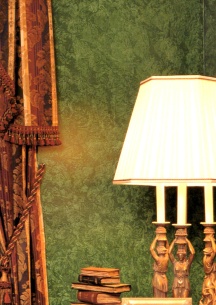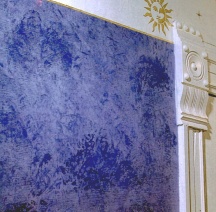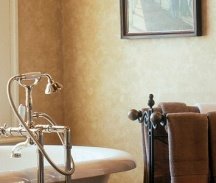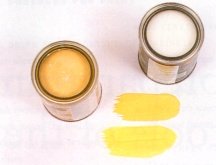How to Faux Paint
Your Walls with Rags
Want to learn how to faux paint with a rag? This painting technique is similar to sponging in many ways, and also produces a decoratively glazed surface.
The process of ragging ON is also called positive, or additive ragging.
This simply means that you use a rag to add colored glaze to a surface (rather than to remove it, as you would in negative, or subtractive ragging).
Additive Rag Painting:
It's a Level Up From Sponging
Both sponging on and ragging on produce a similar mottled look, and give surfaces texture and visual interest by adding a layer of decorative glaze on top of a painted base coat.

However, ragging on gives you more opportunity than sponging on to experiment with and control the texture of the glaze you add to the surface.
The reason is because the way you hold the rag - in addition to the fiber type, weave, size and edges of the cloth - dramatically affect the final outcome of the paint treatment.
In other words, you can get many more looks with this painting method than with sponging.
But before showing you how to faux paint using rags, here are some things you need to know about it:
Color

When ragging on, it's usually best to choose colors that are fairly close to each other - never more than 2 shades in difference, and from the same color family.
For example, you can successfully rag yellow over a cream base, or navy blue over royal blue.
You don't want the contrast between the base and top coat to be too high, or the colors to be unrelated - otherwise the effect will look harsh and gaudy (like those dramatic faux finishes from the 80s).
Finish

As far as the paint finish goes, the rule of thumb is, the less difference there is between the base and top coats (in hue and contrast), the more difference there can be in sheen.
So when using really similar tones for ragging, you can add a bit more dimension to the finish by using flat paint for the base coat, and satin glaze for the overlay.
When the difference between the colors is already easily apparent, you don't need any more drama (it's easy to overdo with all additive painting techniques) - in this case, use the same finish for the top coat that you used for the base (e.g. flat over flat, satin over satin).
Recipe

Just like with sponging on, you never want to use paint straight out of a can for ragging on. If you do, you'll end up with a sticky, smudgy mess on your walls - most likely, not the look you're going for!
For the paint to be workable with this method, it needs to be thinned and diluted.
You don't have to use alkyd/oil-based paint for positive ragging (unless you want to, for some reason), so here's a formula that's both easy to work with and easy to clean up after:
1 part latex paint + 1 part clear glazing liquid + 1 part water
This water-based (latex or acrylic) mix will create a delicate, semi-translucent layer of color and should hold up well on the walls as it dries, with no runs or smudges.
How to Faux Paint with Rags:
Step by Step Instructions
Even though this painting method appears easy, it isn't. It takes practice to touch the bunched cloth to the surface with just the right amount of pressure so that the cloth makes a mark without losing its shape or falling out of your hand.
So hone your skills on a practice board before starting on your walls.
1 Color Rag Painting Tutorial - the Basic Technique
If you've ever tried the sponging on technique , basic ragging on will be easier for you to learn - both the instructions and the process will feel familiar. …
2 Color, Tone-On-Tone Paint Ragging Instructions
This technique is a logical continuation of ragging on one color - it begins where the basic method leaves off. This process adds a second color glaze …
3 Color Ragging On Decorative Painting Technique
This multi-tonal rag painting method uses 3 colors from the same paint strip, to create an interesting yet subdued effect. And even though you'll work …
Pounced and Twisted Rag Painted Method
This technique produces a heavily glazed surface, but with a more stylized, floral-like texture, because here you use a different hand motion than in traditional …
How to Rag Roll Paint On Your Walls
In rag rolling, you work with a roll of cloth that produces a rhythmic linear pattern - in contrast to the random effect of the loosely bunched rag in …
Rag Painting the Walls for a Faux Tuscan Effect
The warm and vibrant colors used in this rag painting technique remind us of the baking heat of a Tuscan summer, and the rough and uneven texture of the …
See Also:
Negative Rag Painting: How-to Tutorials
Examples of Ragging Faux Finish Techniques
Tips and Tricks for Ragging Faux Painting Finishes















Leave a Comment: